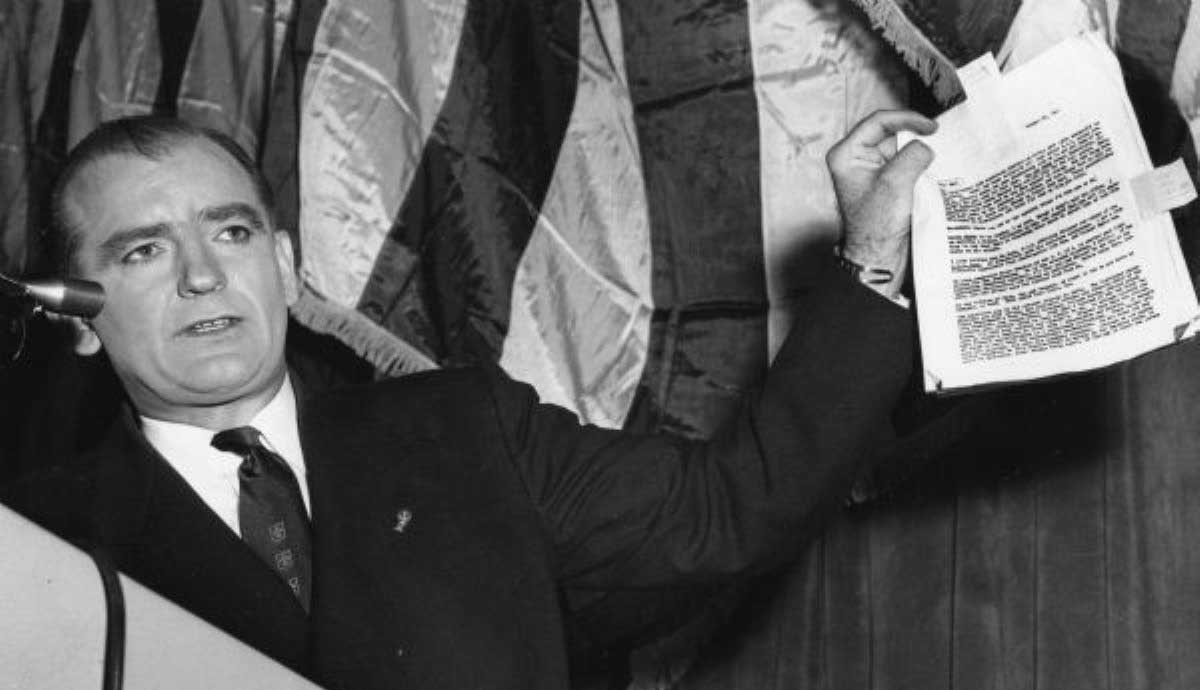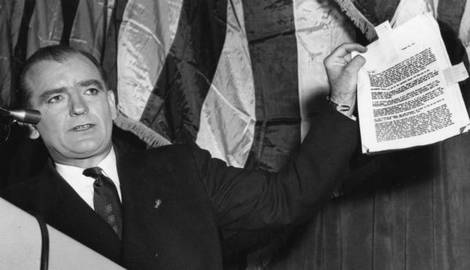
In the midst of the Cold War, a US senator from Wisconsin took the meaning of anti-Communism to a new level when he accused federal government employees of being disloyal to the nation due to communist ties. The term McCarthyism is named after Senator McCarthy and is often used synonymously with the height of the second Red Scare. In the early 1950s, the American public was advised to be wary of communist influences lurking across the nation, and it caused mass hysteria. As the Soviet Union was spreading the Communist movement across Eastern and Central Europe and parts of Asia, communist expansion in the West became an increasing threat to the public and national security.
The Birth of McCarthyism

McCarthyism is a term used alongside the period of the second Red Scare that took place between 1947 and 1957. The term is associated with former United States Senator Joseph McCarthy from Wisconsin. McCarthyism refers to the public and falsely or loosely evidenced accusations that deemed federal government employees disloyal to the nation. One of the first uses of McCarthyism was in a Washington Post editorial released in March 1950. A cartoon created by Herbert Block entitled “You Mean I’m Supposed to Stand on That?” depicted Republican Senators Styles Bridges, Kenneth S. Wherry, and Robert A. Taft pushing and pulling on an elephant used as a Republican symbol toward a stack of tar buckets. On top of the buckets is a barrel labeled with the phrase McCarthyism holding up a small platform.
Joseph Raymond McCarthy was born in Grand Chute, Wisconsin on November 14, 1908. He attended school periodically but dedicated most of his time to farm labor to help support his family. He enrolled in high school at the age of 19 and completed all four years of coursework within one year. McCarthy enrolled at Marquette University in 1930 with the intention of studying engineering, but later switched to law and graduated in 1935. He went on to pass the Wisconsin bar exam and began a career in the legal field.

McCarthy entered the political arena when he was elected as a circuit judge in 1939. He served in the US Marine Corps during the Second World War and returned to his position following the end of the war. His career as a circuit judge ended when he was elected as a US Senator on behalf of the Republican Party in 1946. McCarthy didn’t stand out as a senator during his first few years. However, he quickly became a notable figure following a speech he gave in Wheeling, West Virginia to the Women’s Republican Club.
On February 9, 1950, McCarthy gave a speech in Lincoln’s birthday address that warned of communist infiltration within the US government. He did so by stating:
“While I cannot take the time to name all the men in the State Department who have been named as members of the Communist Party and members of a spy ring, I have here in my hand a list of 205.”
McCarthy’s claims that he held a list of government officials associated with the Communist Party sparked a mass hysteria phenomenon that fueled the second Red Scare. The American public became extremely fearful of communist involvement, so much so that people lost their jobs and were blacklisted from entering certain organizations and federal government agencies.
The First Red Scare Phenomenon

The late 1940s Red Scare wasn’t the first time that mass paranoia of communism struck the nation. The first Red Scare appeared in 1919 when American socialists and radicals banded together to create the American Communist Party, which was largely influenced by the successful Russian Communist Party and Bolshevik Revolution. The Russian Communist Party created the Comintern, also referred to as the Communist International, to help push the Communist movement forward and establish influences in other parts of Europe. By 1922, two American Communist parties existed and had about 12,000 members.
Over the next decade, the American Communist Party expanded significantly to about 75,000 members. Communist influences within the US caused fear and hostility among the public, especially against immigrants. The first Red Scare led to thousands of individuals being accused of communist or anarchist relations.
The Palmer Raids was one of the most significant events of the first Red Scare, which was conducted by the US Department of Justice and led by J. Edgar Hoover. During the raids, between 3,000 and 10,000 individuals who were suspected of communist, socialist, or anarchist ties were detained. Many individuals who were detained were deported. The actions of the Palmer Raids were deemed constitutional since socialist, communist, and anarchist associations were thought to correlate with advocating for the overthrow of the US government.
Roots of the Second Red Scare

The unstable relationship between the United States and the Soviet Union became more apparent following World War II when political disagreements grew into competition over world power and influence. The heightened tensions between the two forces led to conflicts that threatened a third World War and the spread of Communism – a period known as the Cold War. Although the population of the US reached about 150 million in 1950 and only some 50,000 Americans were members of the Communist Party, the fear that Communism would take over the nation dominated the 1950s.
President Harry S. Truman reluctantly decided to launch the Federal Loyalty-Security Program through the signing of Executive Order 9835 to prevent communist infiltration within the US government. The program established loyalty boards, which were allowed to conduct investigations if there was any reasonable doubt that disloyalty existed. The Federal Bureau of Investigation (FBI) was authorized to conduct investigations alongside the loyalty boards to help with the mass amount of inquiries they received on suspected individuals.
Loyalty boards were established in every federal agency and conducted reviews and hearings on federal employees. More than five million federal employees were investigated. Even being suspected of having communist relations or being a sympathizer was enough for people to lose their jobs. Thousands of employees resigned as a result, and several hundred were dismissed. Many of those who were accused had their political and social reputations damaged. Prior to the establishment of the Loyalty Order, the House Un-American Activities Committee (HUAC) was created in 1938 to investigate the disloyalty of individuals and organizations. The committee later became an important entity in the disloyalty inquiries and investigations that ensued throughout the 1950s.
The Grip of McCarthyism on the Second Red Scare

Senator McCarthy capitalized on the nation’s paranoia of Communism and used it to gain notoriety. As he stepped onto the scene of anti-Communism by claiming he knew of State Department employees who were involved in communist activities, it heightened the state of fear and paranoia. Many political leaders used it as a way to launch anti-Communism political campaigns to win elections in the early 1950s.
McCarthy took his efforts even further when he started a series of probes for communist infiltration within the State Department, Treasury, and the White House. He also launched an investigation for communist infiltration in the US Army. These probes were highly publicized, and his accusations were often knowingly false or lacked sufficient evidence to be pursued. However, politicians and federal officials avoided confronting McCarthy for his outlandish accusations, fearing that they would be accused of communist subversion and have their reputation damaged.

Influenced by McCarthy’s accusations of federal employee disloyalty, the Ohio General Assembly created the Ohio Un-American Activities Committee to investigate communist influences in the state. The committee was modeled after the HUAC and targeted state and federal government employees, government organizations, and even significant figures in Hollywood. Although many supported the actions the state and federal governments were taking to prevent the spread of Communism, some thought it violated free speech and privacy rights. Soviet spy rings and communists acting in favor of a foreign power did infiltrate federal government operations during World War II and the Cold War.
For example, the Rosenberg trial was a highly controversial case that resulted in the first Americans, Julius and Ethel Rosenberg, being executed based on conspiracy to commit espionage during peacetime. The trial began in 1951, just as McCarthy began spewing accusations about government employee disloyalty. It was later determined that Julius was the leader of a Soviet spy ring and recruited and coordinated with other individuals to share secrets of the atomic bomb with the Soviets. Communist infiltration within the US government was present, and it did affect certain outcomes. Soviet spies who infiltrated US government operations were largely responsible for the Soviet Union’s ability to test its first atomic bomb in August 1949. The test came years earlier than what experts had projected for this type of Soviet weapons development.
The Downfall of McCarthyism

The Cold War didn’t end until 1991 along with the dissolution of the Soviet Union, but McCarthyism died out in the mid-1950s. The second Red Scare also dissolved along with McCarthyism. Senator Joseph McCarthy was largely responsible for his own downfall, which began when he launched a series of probes against the US Army for communist subversion as chairman of the Senate Permanent Subcommittee on Investigations in 1953. Although he managed to get away with accusing more than 200 federal employees of disloyalty, accusations against the US Army were a longshot.
The committee conducted a series of hearings, known as the Army-McCarthy hearings, which were broadcast on national television. While conducting the hearings, McCarthy was described as acting belligerent and inappropriately. His behavior made it more apparent that his accusations were false, causing him to lose what remaining trust the public had in him.
Adding onto his embarrassing behaviors, the US Army countered the accusations by alleging that McCarthy was abusing his power as he requested special treatment for one of his former employees. This made him a subject of the committee’s investigation and caused him to step down from his position as chairman. In December 1954, McCarthy was censured by the US Senate but kept his position until he died on May 2, 1957. Fear of Communism was still present among the American public following the period of McCarthyism. However, paranoia of communist infiltration and influence reached its highest point when Senator McCarthy launched his highly publicized, witch-hunt-like probes on federal employees between 1950 and 1954.










